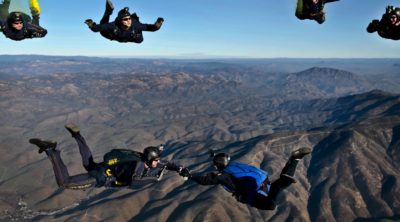
The first time in any sport can be quite frightening and in some cases, slightly injurious as insufficient knowledge can result in accidents. With the sport of skydiving, one must be cautious with safety procedures, as well as be prepared mentally. Scroll below to learn some handy tips for your first sky jump.
If you seek one of the best and greatest thrills the sky has to offer, then skydiving is the sport for you. Nothing pushes your adrenaline, fear and your mental stability to the max, quite like voluntarily jumping out of a plane at a height of 13,000 feet with just a parachute. The wind in your hair, bird’s-eye view of the Earth, flying and gliding through the sky and the ground rushing up to meet you, skydiving promises you a short but exhilarating experience like no other. But it’s very easy to talk about jumping and all, the experience of skydiving for beginners is a little more complex and a lot more frightening. Below are some tips and hints for a first time skydiver to follow.
10 Tips for Skydiving for the First Time
Tip #1: Invest in your safety by choosing a good skydiving school. Do your research in advance, by learning what safety procedures and certifications are to be followed. Dig deep into the school’s safety record and reputation. The United States Parachute Association (USPA) is a necessary certification, look for a school whose instructors are certified by this standard. Talk to trainers personally, meet ex-students of a school prior to joining up and try to attend a demo class, so you get a feel of how things are handled in the institute.
Tip #2: Read the fine print. Skydiving does have its restrictions and dangers. The age limit is 18 years and above, weight limit is 220 lbs (men) and 200 lbs (women). Plus, you need to be healthy enough to jump. Heart problems, low or high blood pressure, motion sickness, nervous breakdowns etc. with such health issues, skydiving is not the sport for you. You will need to fill out a medical form, citing your medical history. Be truthful with such forms, the school is just looking out for your safety. If needed, seek a doctor’s approval for skydiving.
Tip #3: Pay attention during the training procedures. See what your instructor is doing and try to copy him/her as closely as possible. Do not hesitate to ask questions, clarify your doubts and make sure you have understood everything clearly. Take notes if you want. Do not dream during training and take the procedures seriously.
Tip #4: For a first time experience, even with training and instructions, skydiving can be very daunting. So choose the right method of jumping. You can jump solo or skyjump in tandem, where an instructor shares your parachute harness and controls its deployment. He/she will also instruct you on the correct procedure and you learn more and gain confidence. Sometimes you are given a choice, some schools will allow only tandem jumping for first timers.
Tip #5: Learn basic signs and gestures to communicate during your free fall. You cannot speak clearly due to the force of the wind and most probably, no one will be able to hear you either! So use sign language to communicate.
Tip #6: Be meticulous about the proper skydiving safety procedures and equipment. Wear a helmet and goggles. Check all your gear prior to jumping. Consult with your instructor as to what gear is right for you.
Tip #7: Eat something light before your first jump. You may feel very queasy and uneasy prior to and while jumping, so jumping on a full or overfull stomach is not a good idea.
Tip #8: Remember to breathe. At high altitudes, you need more oxygen and deep breathing helps combat stress.
Tip #9: It helps if before the jump, you prepare yourself mentally with some self-meditation and calming techniques. Take some quiet time just to steady and ready yourself. Remember your lessons and training steps, go through them in your mind. If talking distracts you from your fear, talk to someone but do not pester others. Relax and empty your mind of day-to-day worries and just look forward to the experience.
Tip #10: Face and forget your fears. You will free fall for just 1-2 minutes. Enjoy the experience for its short duration, with your eyes wide open. Try to capture the experience, if the jump has a cameraman along or an instructor is clicking snaps. For those Kodak skydiving moments to treasure later, look at the camera and wave.
Skydiving can be such a thrilling, death-defying experience, that just one go may not satisfy the daredevil in you. If so, get certified from a recognized school, so you can attempt more solo jumps and even teach others about the sport. Hopefully the above tips will help you enjoy this free falling, exhilarating experience.


